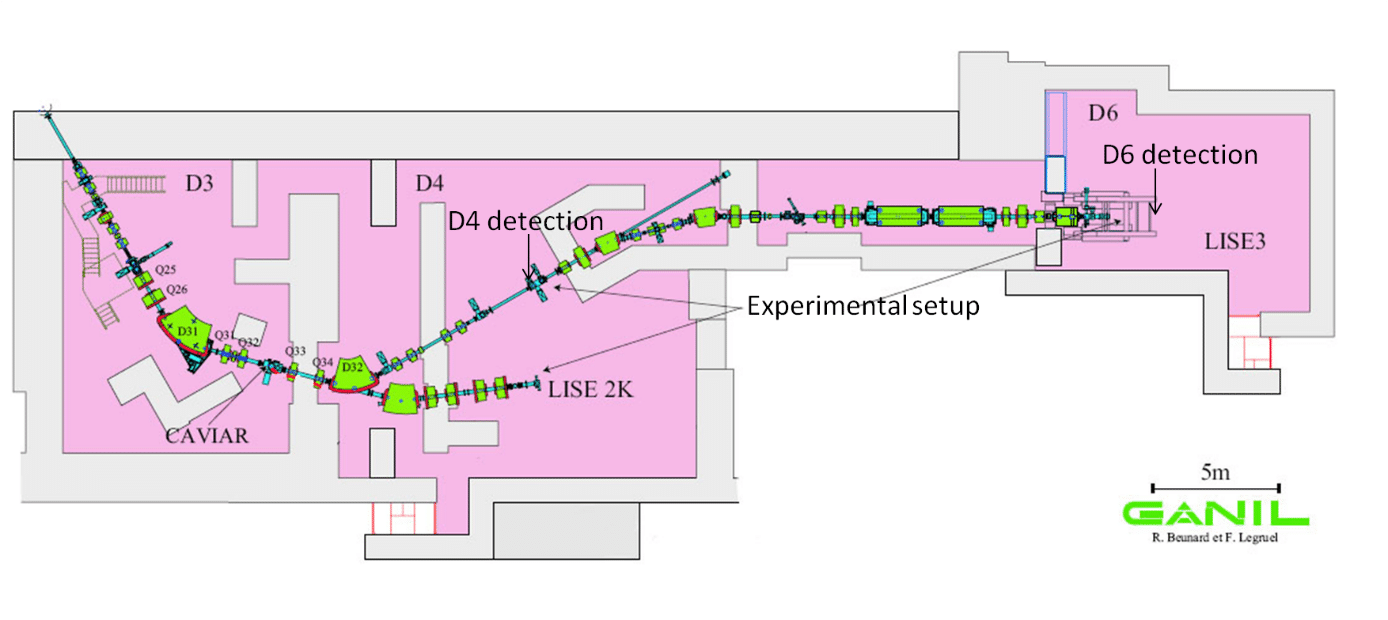- Homepage
- >
- Scientists
- >
- GANIL-SPIRAL 2 facilities
- >
- Experimental areas
- >
- D3-D6 / LISE
- Accelerators
- Available beams
- Experimental areas
- ARIBE
- D1
- D2
- D3-D6 / LISE
- D5
- DESIR
- G1 / VAMOS
- G2
- G3
- G4
- IRRSUD
- LIRAT
- NFS – Neutrons for Science
- S3 – Super Separator Spectrometer
- Instrumentation
- ACTAR TPC
- AGATA
- CHATEAU DE CRISTAL
- DIAMANT
- EXOGAM / EXOGAM2
- FAZIA
- INDRA
- LPCTrap
- MORA
- MUST2
- NEDA
- PARIS
- REGLIS3
- S3 Low Energy Branch
- SIRIUS
D3-D6 / LISE
The LISE (“Ligne d’Ions Super Epluchés”) beam line
Scientific Coordination: Olivier Sorlin, GANIL – olivier.sorlin@ganil.fr, Jean-Charles Thomas, GANIL – thomasjc@ganil.fr
Technical Coordination: Vincent Morel, GANIL – vincent.morel@ganil.fr
The D3, D4 and D6 rooms host the LISE beam line, consisting in the LISE3 [1,2] and LISE 2K spectrometers (see figure below).

Figure: layout of the LISE beam line (D3, D4 and D6 rooms).
Presentation of the LISE beam line
The LISE beam line [1,2] is dedicated to the production and purification of radioactive ion beams resulting from the fragmentation of the high intensity stable beams (typically 100 pnA of 12C to 136Xe ions) delivered by the GANIL cyclotrons at energies ranging from 50 to 95 MeV/u. The purification of the radioactive beams is achieved in three steps using the Brho-∆E selections, added to a velocity selection operated by a Wien filter in the LISE 3 beam line. These secondary beams can be delivered to three different experimental areas where standalone setups can be installed. Secondary reactions were also induced on these radioactive nuclei, such as Coulomb excitation, inelastic scattering and transfer reactions. The high selectivity of the spectrometer allows studying nuclei spanning from the valley of stability to neutron-deficient or neutron-rich nuclei up to A ≤ 70-80.
The velocity filter selection can also be used in a standalone mode to produce and select (super-) heavy radioactive ion beams by means of fusion-evaporation reactions at a few MeV/u.
LISE can also be used to purify the ISOL beams delivered by the SPIRAL1 facility or to transport stable beams up to one of its experimental areas.
Several diagnostic devices provide to users on-line identification parameters such as time-of-flight, position and energy-loss values all along the spectrometer.
Scientific goals
The LISE facility is mainly dedicated to the study of exotic nuclei. Shell evolution, nuclear clustering and pairing, physics at the drip lines, soft/giant/collective modes, exotic decay modes: all these properties are investigated in order to understand the underlying nuclear forces. They are probed at a moderate excitation energy and for a wide range of neutron to proton ratio, thus providing stringent constrains to theoretical models. The produced and/or purified radioactive beams are delivered to a large variety of experimental setups including active targets (ACTAR TPC), charged particle (MUST2), neutron and gamma detection arrays (EXOGAM, Château de cristal).
Other research fields are covered at the LISE facility such as nuclear astrophysics, reaction mechanism studies as well as atomic physics experiments with highly charged and fast ions. Finaly, experiments with polarized beams are also feasible. A publication list can be downloaded here: LISE publications 2002-2018.
Technical details
The LISE line can be operated in three distinct modes:
- The standard “LISE3 mode” allows the selection of secondary beams obtained by the interaction of stable heavy ions with a high power target located in the D3 room. The beam angle on the target can be set from 0 up to 3.5°, the latter allowing to select polarized fragments more favourably. . The fragment selection is performed using two dipole magnets (D31 and D32, selecting the fragments according to their magnetic rigidity) combined with an achromatic degrader located in the intermediate focal plane in the D3 room, which operates an A3/Z2 Experimental setups are either mounted at the intermediate focal point (D4 room) or at the final focal point (D6 room). In the latter case, a Wien filter can be used to operate a third selection according to the secondary beam velocity in order to increase its purity.
- The “LISE 2K mode” for which the D32 dipole is replaced by the D7P one to increase the angular acceptance and the maximum magnetic rigidity of the spectrometer (see table 2). In such a mode, the experimental setup is mounted in D4 at the focal point of the LISE 2K line.
- The “FULIS mode” dedicated to fusion-evaporation reactions using thin targets mounted on a rotating wheel upstream the Wien filter used to separate the primary beam from the reaction products transmitted to D6. The angular acceptance in the FULIS mode is 20 mrad and the velocity acceptance ± 5%.
The LISE++ simulation program [3] can be used to optimize the setting of the LISE spectrometer and to simulate the production and purity of secondary beams.
| LISE3 | LISE 2K | |
| Angular acceptance (msr) | 1 | 3.5 |
| Momentum acceptance (%) | ± 2.5 | ± 2.5 |
| Magnetic rigidity (T.m) | D31 < 4.3
D32 < 3.26 DA1,2 < 3.86 |
D31 < 4.3
D71 < 4.48 |
Table: Acceptances and magnetic rigidities in the LISE3 and LISE 2K modes.
References
[1] R. Anne et al., NIM A257, 215 (1987).
[2] R. Anne and A.C. Mueller, NIM B70, 276 (1992).
[3] O.B. Tarasov and D. Bazin, NIM B376, 185 (2016).
